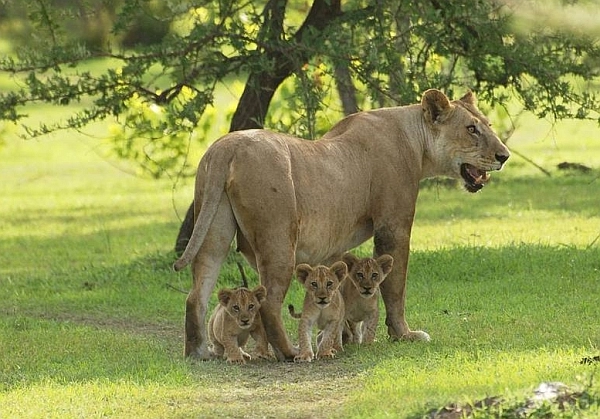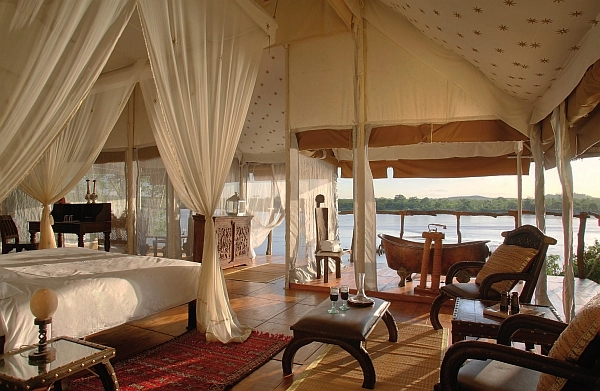Tanzania attractions - The greater part of the northern sector of the Selous (Nyerere National Park) is earmarked for photographic tourism, and it is one of the most beautiful and game-rich areas in the whole ecosystem.

At around 54,600 sq km, the Selous is Africa’s largest game reserve, a wilderness area bigger than Denmark or Switzerland. The Reserve covers more than 5% of Tanzania’s total land area, and is three times larger than the Serengeti. Although slightly off the beaten track of the more well-worn safari circuits, a visit to the Selous offers unforgettable game viewing in almost completely isolated surroundings - one of the best 'secrets of Africa'.
Recently, the Selous has been renamed Nyerere National Park.
The park supports enormous numbers of wild animals: 200,000 buffalo, 30,000 elephant (more than half the country’s population), and 80,000 wildebeest, as well as one of the healthiest populations of the endangered African Wild Dog. A successful project is underway to nurture the Reserve’s population of black rhino back to health following their depletion by poachers in the 1970s and 80s, and sightings are now possible in the tourist area.
In 1982, the Reserve’s unique ecosystem was recognized internationally and the area designated a World Heritage Site by the United Nations.
Three-quarters of the Reserve is woodland of various types, short grassy plains, and seasonally flooded pans. Impressive riverine forests and dense impenetrable thickets are important habitats within the Selous. The wide, meandering Rufiji River is one of the largest water systems in East Africa. With its associated wetlands, lakes and swamps, it is one of the most outstanding ecological systems in the whole of East Africa.
Walking and boat safaris, as well as traditional game drives, are on offer to visitors to the Selous’ small and remote camps and lodges, with little chance of bumping into any sign of human life. Fly camping, or mobile walking safaris, are becoming a popular option for intrepid visitors intent on seeing the best of Africa on foot, unhampered by the closed-in atmosphere of a safari van. Boat trips and longer safaris down the spectacular Rufiji River offer visitors a chance to see hippos, bird life and crocodiles up close. During a game drive or walk one might be lucky enough to see a pack of African wild dogs, disappearing throughout Africa but thriving in the Selous. These complex and fascinating mammals show little fear of vehicles, and it is often possible to observe their intense social life from close proximity. In the tourist area the density of dogs is higher than anywhere else in Africa. The Selous Game Reserve is one of only a few locations in Tanzania where night drives are permitted.
Although the Selous is best known for its spectacular large mammals, it is equally celebrated for its abundant and varied birds. The most conspicuous bird life is to be found around the constantly changing pattern of sandbanks, oxbow lakes, lagoons and channels along the Rufiji River. The river scenery is made all the more spectacular by the groves of Borassus palms, an indigenous species with tall fronds that sway majestically in the African breeze. Ancient baobabs, a tree held sacred by many tribal groups, stand majestically against the far-reaching horizon. Their dead, hollow, leafless trunks provide vantage points for Fish Eagles and nest sites for Egyptian Geese and Dickinson’s Kestrels.

There are many luxury lodges in the Selous Game Reserve
When to go
Game viewing in Selous Game Reserve is good all year round. There are no migratory patterns that effect the chances of having exceptional game viewing. However, the weather can play a factor in your planning.
Flights do not operated to Selous from around 21 March through 31 May. This is because frequent rain showers can make the airstrips unusable. Due to Selous being at a lower elevation than the parks in Tanzania’s northern circuit, it can become hot and humid. From October to January the heat is more noticeable than in other months of the year. However, there is good shade and usually a breeze. During November, there is a chance of some rain showers.
Prices are often lower between January and March and again in November.
How to get there
Most travelers fly in and out of Selous Game Reserve. The flight from Dar es Salaam takes about 45 minutes but could be longer depending on the number of stops at the various airstrips the plane makes. There are several flights daily.
If you are traveling from Northern Tanzania, you fly via Dar es Salaam with stops there and in Arusha.
The flight from Seronera departs at 10.35am and arrives at approximately 3.15pm.
Game viewing in Selous Game Reserve is good all year round. There are no migratory patterns that effect the chances of having exceptional game viewing. However, the weather can play a factor in your planning.
Flights do not operated to Selous from around 21 March through 31 May. This is because frequent rain showers can make the airstrips unusable. Due to Selous being at a lower elevation than the parks in Tanzania’s northern circuit, it can become hot and humid. From October to January the heat is more noticeable than in other months of the year. However, there is good shade and usually a breeze. During November, there is a chance of some rain showers.
Prices are often lower between January and March and again in November.
How to get there
Most travelers fly in and out of Selous Game Reserve. The flight from Dar es Salaam takes about 45 minutes but could be longer depending on the number of stops at the various airstrips the plane makes. There are several flights daily.
If you are traveling from Northern Tanzania, you fly via Dar es Salaam with stops there and in Arusha.
The flight from Seronera departs at 10.35am and arrives at approximately 3.15pm.
We have some itinerary ideas at Tanzania Suggested Itineraries but we can This email address is being protected from spambots. You need JavaScript enabled to view it. or use some of our Tanzania Safari Specials.
